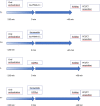Effects of furosemide and tracer selection on urinary activity and peri-bladder artefacts in PSMA PET/CT: a single-centre retrospective study
- PMID: 35895129
- PMCID: PMC9329505
- DOI: 10.1186/s13550-022-00913-y
Effects of furosemide and tracer selection on urinary activity and peri-bladder artefacts in PSMA PET/CT: a single-centre retrospective study
Abstract
Background: High urinary activity in urinary bladder and ureters may hamper interpretation of prostate cancer and regional nodal metastases in prostate-specific membrane antigen (PSMA) PET/CT. The goal of this study was to assess effects of furosemide and choice of tracer on urinary activity in the bladder and ureters, as well as on occurrence of peri-bladder artefacts in PET/CT.
Methods: Four cohorts with a total of 202 men staged with PSMA PET/CT for prostate cancer received either 68Ga-PSMA-11 as tracer, with (cohort G+) or without 10mg intravenous furosemide (G-) concurrent with tracer, or 18F-DCFPyL with (F+) or without furosemide (F-). SUVmax of bladder and ureters, presence, type, and severity of peri-bladder artefacts were compared between cohorts. The influence of furosemide and choice of tracer was determined while taking differences in biodistribution time into account.
Results: Median SUVmax bladder was 43,5; 14,8; 61,7 and 22,8 in cohorts G-, G+, F- and F+, respectively, resulting in significant overall (p < 0.001) and between cohort differences (p adjusted < 0.001 to 0.003) except between G- and F+. Median SUVmax ureter was 6.4; 4.5; 8.1 and 6.0 in cohorts G-, G+, F- and F+, respectively, resulting in significant overall (p < 0.001) and between cohort differences for G+ : F- and F- : F+ (p < 0.001, respectively, 0.019). Significant effects of furosemide and choice of tracer on SUVmax bladder (p < 0.001 resp. p = 0.001) and of furosemide on SUVmax ureter (p < 0.001) were found, whereas differences in biodistribution time had not impacted these results significantly. Peri-bladder artefacts were present in 42/202 (21%) patients and were significantly more frequent in the F- cohort, respectively, less frequent in the G+ cohort (p = 0.001 resp. p < 0.001). Peri-bladder artefacts had a direct positive correlation with SUVmax bladder (p = 0.033).
Conclusions: Increased urinary activity and higher incidence of peri-bladder artefacts were found in 18F-DCFPyL compared to 68Ga-PSMA-11 PET/CT. Effective reduction of urinary activity may be reached through forced diuresis using 10mg intravenous furosemide, which is especially advantageous in 18F-DCFPyL PET/CT.
Keywords: Furosemide; PSMA; Prostate cancer; Sensitivity.
© 2022. The Author(s).
Conflict of interest statement
The authors declare that they have no competing interests.
Figures


Similar articles
-
Bladder activity of different PSMA PET radioligands and impact of furosemide.Res Sq [Preprint]. 2025 May 8:rs.3.rs-6537072. doi: 10.21203/rs.3.rs-6537072/v1. Res Sq. 2025. PMID: 40386385 Free PMC article. Preprint.
-
Impact of forced diuresis with furosemide and hydration on the halo artefact and intensity of tracer accumulation in the urinary bladder and kidneys on [68Ga]Ga-PSMA-11-PET/CT in the evaluation of prostate cancer patients.Eur J Nucl Med Mol Imaging. 2021 Jan;48(1):123-133. doi: 10.1007/s00259-020-04846-3. Epub 2020 May 8. Eur J Nucl Med Mol Imaging. 2021. PMID: 32385647
-
Effect of forced diuresis during 18F-DCFPyL PET/CT in patients with prostate cancer: activity in ureters, kidneys and bladder and occurrence of halo artefacts around kidneys and bladder.Nucl Med Commun. 2019 Jun;40(6):652-656. doi: 10.1097/MNM.0000000000001007. Nucl Med Commun. 2019. PMID: 30855543
-
More advantages in detecting bone and soft tissue metastases from prostate cancer using 18F-PSMA PET/CT.Hell J Nucl Med. 2019 Jan-Apr;22(1):6-9. doi: 10.1967/s002449910952. Epub 2019 Mar 7. Hell J Nucl Med. 2019. PMID: 30843003
-
Errors in the ultrasound diagnosis of the kidneys, ureters and urinary bladder.J Ultrason. 2013 Sep;13(54):308-18. doi: 10.15557/JoU.2013.0031. Epub 2013 Sep 30. J Ultrason. 2013. PMID: 26674139 Free PMC article. Review.
Cited by
-
Prognostic significance of a negative PSMA PET/CT in biochemical recurrence of prostate cancer.Cancer Imaging. 2024 Aug 30;24(1):117. doi: 10.1186/s40644-024-00752-1. Cancer Imaging. 2024. PMID: 39210431 Free PMC article.
-
Bladder activity of different PSMA PET radioligands and impact of furosemide.Res Sq [Preprint]. 2025 May 8:rs.3.rs-6537072. doi: 10.21203/rs.3.rs-6537072/v1. Res Sq. 2025. PMID: 40386385 Free PMC article. Preprint.
-
Furosemide Reduces Radionuclide Activity in the Bladder in 18F-PSMA-1007-PET/CT: A Single-Center Retrospective Intra-Individual Comparative Study.Diagnostics (Basel). 2025 Jul 31;15(15):1931. doi: 10.3390/diagnostics15151931. Diagnostics (Basel). 2025. PMID: 40804895 Free PMC article.
-
[18F]PSMA-1007 PET is comparable to [99mTc]Tc-DMSA SPECT for renal cortical imaging.Eur J Hybrid Imaging. 2023 Nov 24;7(1):25. doi: 10.1186/s41824-023-00185-2. Eur J Hybrid Imaging. 2023. PMID: 37996712 Free PMC article.
-
The accuracy and intra- and interobserver variability of PSMA PET/CT for the local staging of primary prostate cancer.Eur J Nucl Med Mol Imaging. 2024 May;51(6):1741-1752. doi: 10.1007/s00259-024-06594-0. Epub 2024 Jan 26. Eur J Nucl Med Mol Imaging. 2024. PMID: 38273003 Free PMC article.
References
-
- Hofman MS, Lawrentschuk N, Francis RJ, et al. Prostate-specific membrane antigen PET-CT in patients with high-risk prostate cancer before curative-intent surgery or radiotherapy (proPSMA): a prospective, randomised, multicentre study. The Lancet. 2020;395:1208–1216. doi: 10.1016/S0140-6736(20)30314-7. - DOI - PubMed
LinkOut - more resources
Full Text Sources
Miscellaneous

